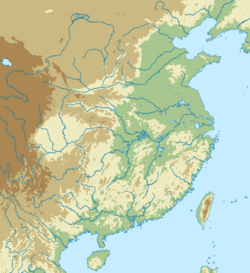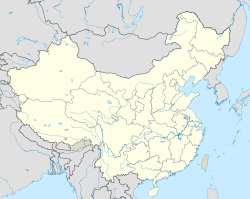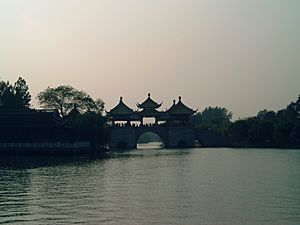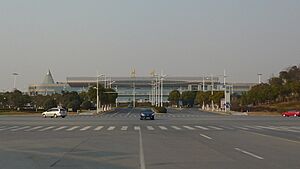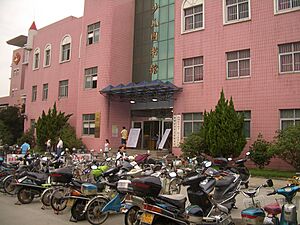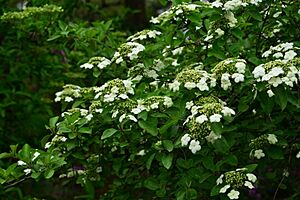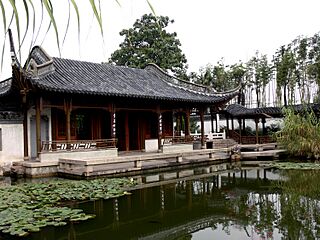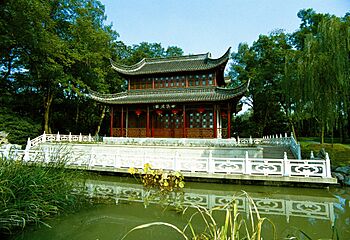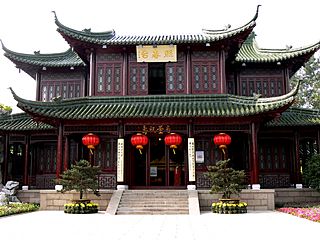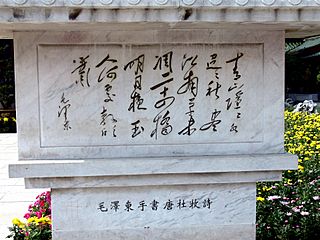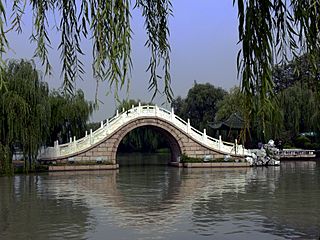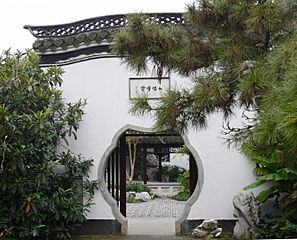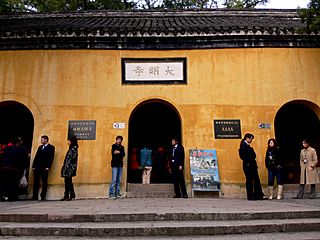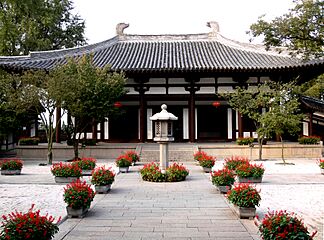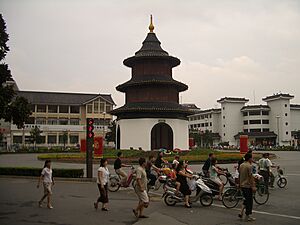Yangzhou facts for kids
Quick facts for kids
Yangzhou
扬州市
Yangchow
|
|
|---|---|
|
Prefecture-level city
|
|
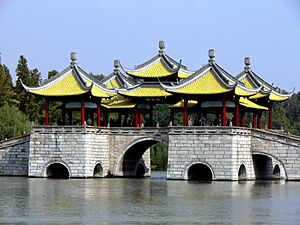
Five-Pavilion Bridge and the Slender West Lake
|
|
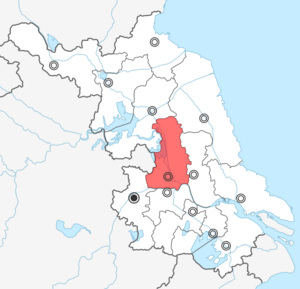
Location of Yangzhou administrative area in Jiangsu
|
|
| Country | People's Republic of China |
| Province | Jiangsu |
| County-level divisions | 6 (3 Districts, 2 County-level cities, 1 County) |
| Municipal seat | Hanjiang District |
| Area | |
| • Prefecture-level city | 6,626 km2 (2,558 sq mi) |
| • Urban
(2018)
|
363 km2 (140 sq mi) |
| • Metro | 2,310 km2 (890 sq mi) |
| Population
(2020 census)
|
|
| • Prefecture-level city | 4,559,797 |
| • Density | 688.17/km2 (1,782.35/sq mi) |
| • Urban
(2018)
|
1,665,000 |
| • Urban density | 4,587/km2 (11,880/sq mi) |
| • Metro | 2,635,435 |
| • Metro density | 1,140.9/km2 (2,955/sq mi) |
| Includes only those with Hukou permits | |
| GDP | |
| • Prefecture-level city | CN¥ 546.6 trillion US$ 82.8 billion |
| • Per capita | CN¥ 120,944 US$ 18,311 |
| Time zone | UTC+8 (Beijing Time) |
| Telephone | (0)514 |
| ISO 3166 code | CN-JS-10 |
| Licence plate prefixes | 苏K |
| Yangzhou | |||||||||||||||||||
|---|---|---|---|---|---|---|---|---|---|---|---|---|---|---|---|---|---|---|---|

"Yangzhou" in Simplified (top) and Traditional (bottom) Chinese characters
|
|||||||||||||||||||
| Traditional Chinese | 揚州 | ||||||||||||||||||
| Simplified Chinese | 扬州 | ||||||||||||||||||
| Literal meaning | [Seat of] Yang Province | ||||||||||||||||||
|
|||||||||||||||||||
| Historical Names Hancheng |
|||||||||||||||||||
| Chinese | 邗城 | ||||||||||||||||||
| Literal meaning | Han City | ||||||||||||||||||
|
|||||||||||||||||||
| Guangling | |||||||||||||||||||
| Traditional Chinese | 廣陵 | ||||||||||||||||||
| Simplified Chinese | 广陵 | ||||||||||||||||||
| Literal meaning | Expansive Tomb | ||||||||||||||||||
|
|||||||||||||||||||
| Jiangdu | |||||||||||||||||||
| Chinese | 江都 | ||||||||||||||||||
| Literal meaning | Capital on the [Yangtze] River | ||||||||||||||||||
|
|||||||||||||||||||
Yangzhou is a big city in central Jiangsu Province, East China. It sits on the north side of the Yangtze River. Yangzhou is next to Nanjing to the southwest, Huai'an to the north, Yancheng to the northeast, Taizhou to the east, and Zhenjiang across the river to the south. In 2020, about 4.5 million people lived in Yangzhou. The main city area is home to over 2.6 million people.
For a long time, Yangzhou was one of the richest cities in China. It was famous for its rich merchant families, poets, artists, and smart people. The name "Yangzhou" means "Rising Prefecture." This name comes from its past as the capital of an old area called Yangzhou prefecture in imperial China. Yangzhou was one of the first cities in China to get a loan from the World Bank. This money was used to build a power station in 1994.
Contents
- Understanding Yangzhou's Government
- Yangzhou's Long History
- Yangzhou's Geography and Climate
- Getting Around Yangzhou: Transportation Guide
- Yangzhou's Industries and Shipyards
- Yangzhou's Rich Culture
- Exploring Yangzhou: Tourist Attractions
- Slender West Lake: A Scenic Gem
- Daming Temple: A Historic Buddhist Site
- Flat Hills Hall: A Scholar's View
- Pavilion of Flourishing Culture: City's Heart
- Stone Pagoda: Yangzhou's Oldest Pagoda
- Tomb of Puhaddin: A Historic Muslim Site
- Ge Garden: A Beautiful Chinese Garden
- He Garden: A Garden with a Long Corridor
- Yechun Garden: A Rustic Retreat
- Yangzhou Museum: History and Printing
- Jiangdu Hydro Project: Moving Water North
- Learning in Yangzhou: Education
- Yangzhou's Sister Cities
- See also
Understanding Yangzhou's Government
Yangzhou is a "prefecture-level city," which means it's a large city that also manages several smaller areas around it. Currently, Yangzhou oversees six county-level divisions. These include three districts, two cities that are like counties, and one county. These areas are then divided into 98 smaller parts, like towns and subdistricts.
| Map | |||||
|---|---|---|---|---|---|
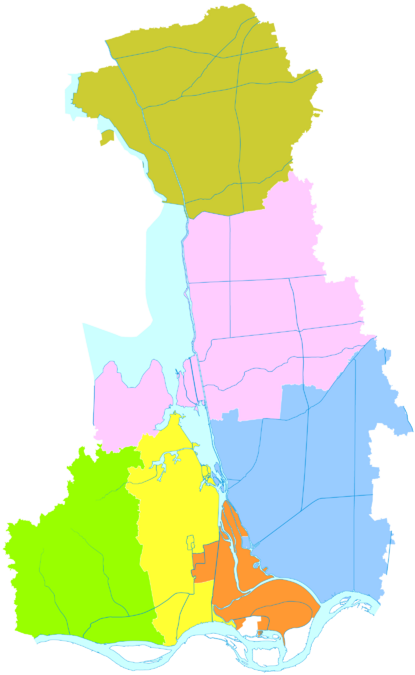
Gaoyou
Lake Guangling
Hanjiang
Jiangdu
Baoying
County Yizheng
(city) Gaoyou
(city) |
|||||
| Subdivision | Simplified Chinese | Hanyu Pinyin | Population (2020) | Area (km2) | Density (/km2) |
| City Proper | |||||
| Guangling District | 广陵区 | Guǎnglíng Qū | 542,305 | 423.09 | 805.92 |
| Hanjiang District | 邗江区 | Hánjiāng Qū | 726,906 | 552.68 | 1,902.23 |
| Suburban | |||||
| Jiangdu District | 江都区 | Jiāngdū Qū | 926,577 | 1,329.90 | 757.03 |
| Rural | |||||
| Baoying County | 宝应县 | Bǎoyìng Xiàn | 682,219 | 1,461.55 | 514.57 |
| Satellite cities (County-level cities) | |||||
| Yizheng | 仪征市 | Yízhēng Shì | 532,571 | 902.20 | 625.08 |
| Gaoyou | 高邮市 | Gāoyóu Shì | 709,572 | 1,921.78 | 387.49 |
| Total | 4,559,797 | 6,591.21 | 676.62 | ||
| In November 2011, Weiyang District (维扬区) was merged into Hanjiang District, while the former county-level Jiangdu City became Jiangdu District. |
|||||
Yangzhou's Long History
Early Beginnings in Ancient China
Yangzhou has a very old history. During the Spring and Autumn period (a time in ancient China), a powerful leader named Fuchai of Wu built the Han Canal around 486 BC. This canal helped him move supplies from his main city, Suzhou, to the north. It connected the Yangtze River near Yangzhou to the Huai River.
The next year, Fuchai built a fort called Hancheng to protect the canal's southern end. This fort was built like a square, about 12 meters above the river. The Han Canal acted like a moat around the city. The fort was meant to stop attacks from enemies coming down the canal.
Yangzhou in Imperial China
Later, under the Eastern Han dynasty, the area was called Guangling Commandery. Its main city, also named Guangling, was near where the Yangtze River and Han Canal met.
In AD 590, during the Sui dynasty, Guangling became Yang Province. The city also took this new name. Yangzhou grew very rich when Emperor Yang of Sui connected the Han Canal to other waterways. This created the main part of the Grand Canal of China. Yangzhou then became the southern capital of China, called Jiangdu. Emperor Yang even made Jiangdu his main capital for a short time.
During the Tang dynasty, Yangzhou became a major port for trade with other countries. Many foreign merchants, including Koreans, Arabs, and Persians, lived there. Sadly, in 760, thousands of Muslim Arab, Persian, and other foreign merchants were killed during a rebellion.
Yangzhou was briefly the capital of a kingdom called Wu during the Five Dynasties and Ten Kingdoms period.
In 1127, after the Jurchen people took over Kaifeng, the Song dynasty used Yangzhou as their capital in 1128 and 1129. Later, the Song army tried to stop the Jurchen army by breaking the banks of the Yellow River. This caused the river to change its path, and the Grand Canal was cut off for many years. The Song dynasty then moved its capital to Hangzhou.
In 1280, during the Yuan dynasty, there was a huge gunpowder explosion in Yangzhou. A bomb storage area caught fire, killing over a hundred guards. The blast was so strong that debris flew 10 li (about 5 km) away.
The famous traveler Marco Polo said he worked for Kubilai Khan in Yangzhou around 1282-1287. He might have been an official in the salt business. While Chinese records don't mention him, a tomb from 1342 shows that an Italian trading family lived in Yangzhou. This suggests there was an Italian community there. Also, records show that a Christian official named "Mar Sarchis" (or "Ma Xuelijisi") funded two churches in China.
During the Ming dynasty (1368–1644), Yangzhou was a very important trading center for salt, rice, and silk. The Ming rulers built the city as it looks today, with 9 km of walls. This was to protect it from pirate attacks.
Yangzhou also had a community of Hui (Chinese Muslim) people during the Yuan, Ming, and Qing dynasties. There are old mosques, like the Crane Mosque, and the tomb of Sayyid Puhaddin.
After Beijing fell to the Manchus in 1644, Yangzhou was still controlled by the Southern Ming government. But in 1645, Qing forces took Yangzhou after a short fight. The city's main defender, Shi Kefa, was killed. A terrible event called the Yangzhou massacre followed. While one account claimed 800,000 victims, this number is likely too high.
The city quickly recovered and became very rich again during the Qing dynasty. This was because it was the center for the government's salt business. Yangzhou was famous for its literature, art, and the beautiful gardens of its rich merchant families. Even the emperors Kangxi and Qianlong visited these gardens.
In 1868, the Yangzhou riot happened. This was a big event in the relationship between China and Britain. City officials were against foreign Christian missionaries being there. A large crowd attacked the British China Inland Mission building, looting and burning it. Missionaries, including Hudson Taylor, were hurt but no one died. This led to a strong response from the British, and the Chinese government apologized and paid for the damages.
Yangzhou in Modern China
From the time of the Taiping Rebellion (1853) until the 1980s, Yangzhou faced hard times. It was damaged by wars, and the Grand Canal became less important as railways grew. During the Second Sino-Japanese War, the Japanese occupied Yangzhou for eight years. They used it as a place to hold prisoners, mostly British and Australian civilians from Shanghai.
Yangzhou's importance as a major economic center was never fully restored. It wasn't until the 1990s that the city started to become prosperous again. This was thanks to China's economic growth and special development projects. Now, with the canal partly restored and good train and road connections, Yangzhou is once again an important transportation and market hub. It also produces goods like cotton and textiles. In 2004, a railway line connected Yangzhou to Nanjing for the first time.
Yangzhou's Geography and Climate
Yangzhou is located on a flat area north of the Yangtze River. The Grand Canal runs through the city from north to south. Its modern path goes through the eastern part of Yangzhou, while the old path goes through the city center. Many other rivers and lakes are also in the area, like the Baoshe River, Datong River, and Gaoyou Lake.
The main city area of Yangzhou has many canals and small lakes. The old city center is surrounded by canals. The Old Grand Canal forms its eastern and southern borders. The City Moat Canal runs along the northern edge, connecting to the Slender West Lake. You can even sail a small boat from the Slender West Lake to the Old Grand Canal.
Yangzhou's Weather
Yangzhou has a subtropical monsoon climate. This means it has humid weather with changing winds. Winters last about four months, summers three months, and spring and autumn are shorter, about two months each. The city usually has no frost for 222 days a year and gets around 2,000 hours of sunshine.
The average temperature for the whole year is about 15.72°C. In January, the average temperature is 2.5°C, and in July, it's 28.0°C.
Yangzhou gets about 1043 mm of rain each year. About 45% of this rain falls in the summer. The "plum rain season" is from mid-June to late July. It's called this because plums ripen during this rainy time. The coldest temperature recorded since 1951 was -17.7°C in January 1955. The hottest was 41.1°C in August 2022.
| Climate data for Yangzhou (1991–2020 normals, extremes 1951–present) | |||||||||||||
|---|---|---|---|---|---|---|---|---|---|---|---|---|---|
| Month | Jan | Feb | Mar | Apr | May | Jun | Jul | Aug | Sep | Oct | Nov | Dec | Year |
| Record high °C (°F) | 20.6 (69.1) |
26.4 (79.5) |
29.3 (84.7) |
34.1 (93.4) |
35.8 (96.4) |
37.6 (99.7) |
39.1 (102.4) |
41.1 (106.0) |
37.5 (99.5) |
32.5 (90.5) |
28.3 (82.9) |
22.6 (72.7) |
41.1 (106.0) |
| Mean daily maximum °C (°F) | 7.0 (44.6) |
9.7 (49.5) |
14.7 (58.5) |
21.1 (70.0) |
26.4 (79.5) |
29.2 (84.6) |
32.3 (90.1) |
31.7 (89.1) |
27.7 (81.9) |
22.6 (72.7) |
16.3 (61.3) |
9.6 (49.3) |
20.7 (69.3) |
| Daily mean °C (°F) | 2.8 (37.0) |
5.1 (41.2) |
9.8 (49.6) |
15.9 (60.6) |
21.4 (70.5) |
24.9 (76.8) |
28.4 (83.1) |
27.8 (82.0) |
23.5 (74.3) |
17.8 (64.0) |
11.4 (52.5) |
5.0 (41.0) |
16.2 (61.0) |
| Mean daily minimum °C (°F) | −0.5 (31.1) |
1.5 (34.7) |
5.7 (42.3) |
11.3 (52.3) |
17.0 (62.6) |
21.4 (70.5) |
25.2 (77.4) |
24.8 (76.6) |
20.1 (68.2) |
13.8 (56.8) |
7.4 (45.3) |
1.3 (34.3) |
12.4 (54.3) |
| Record low °C (°F) | −17.7 (0.1) |
−11.8 (10.8) |
−5.7 (21.7) |
0.4 (32.7) |
7.0 (44.6) |
12.6 (54.7) |
18.3 (64.9) |
17.9 (64.2) |
9.9 (49.8) |
0.1 (32.2) |
−5.6 (21.9) |
−12.0 (10.4) |
−17.7 (0.1) |
| Average precipitation mm (inches) | 50.5 (1.99) |
49.1 (1.93) |
75.8 (2.98) |
69.6 (2.74) |
86.2 (3.39) |
165.2 (6.50) |
210.3 (8.28) |
174.2 (6.86) |
74.3 (2.93) |
54.0 (2.13) |
54.1 (2.13) |
36.6 (1.44) |
1,099.9 (43.3) |
| Average precipitation days (≥ 0.1 mm) | 8.7 | 8.9 | 9.9 | 9.1 | 9.5 | 10.7 | 13.1 | 12.1 | 8.3 | 7.1 | 7.9 | 7.1 | 112.4 |
| Average snowy days | 3.9 | 2.9 | 1.0 | 0.1 | 0 | 0 | 0 | 0 | 0 | 0 | 0.4 | 1.4 | 9.7 |
| Average relative humidity (%) | 73 | 72 | 69 | 67 | 68 | 74 | 78 | 79 | 77 | 75 | 75 | 73 | 73 |
| Mean monthly sunshine hours | 129.9 | 128.1 | 156.6 | 180.0 | 189.5 | 149.5 | 173.1 | 184.4 | 164.2 | 168.4 | 146.5 | 141.8 | 1,912 |
| Percent possible sunshine | 41 | 41 | 42 | 46 | 44 | 35 | 40 | 45 | 45 | 48 | 47 | 46 | 43 |
| Source: China Meteorological Administration all-time extreme temperature | |||||||||||||
Getting Around Yangzhou: Transportation Guide
Yangzhou has a large bridge called the Runyang Yangtze River Bridge. It's one of the longest suspension bridges in the world. This bridge connects Yangzhou to Zhenjiang across the Yangtze River.
Air Travel to Yangzhou
The Yangzhou Taizhou International Airport opened in 2012. It serves both Yangzhou and nearby Taizhou. The airport is in the Jiangdu district. Another option is the Nanjing Lukou International Airport, which is about 100 km away. It takes about 1 hour and 40 minutes to get there from central Yangzhou. Before the Yangzhou Taizhou Airport was built, Nanjing's airport was the main way to fly to Yangzhou.
Train Connections in Yangzhou
Yangzhou didn't have passenger train service until 2004. The Yangzhou railway station was built in 2003 and finished a year later. It's on the west side of the city. This station is important for the Nanjing–Qidong railway. You can take direct trains to Nanjing and other big cities like Xi'an, Wuhan, and Guangzhou. There's even an overnight express train to Beijing. High-speed trains also run on this line.
There isn't a direct train from Yangzhou to Shanghai. To go to Shanghai or other places in the Yangtze Delta, you can cross the Yangtze River to Zhenjiang using the Runyang Bridge. From there, you can catch a train from the Zhenjiang Railway Station, which is on the main Nanjing-Shanghai line.
In 2016, work started on a new north-south train line. This line will connect Lianyungan, Huai'an, Yangzhou, and Zhenjiang. A new Yangzhou station will be built on the east side of the city. This new station is expected to open in 2020 and will become the city's main transportation center.
River Transport in Yangzhou
Yangzhou harbor is about 11.5 km south of the city center. It's located where the Beijing–Hangzhou Canal meets the Yangtze River. The water is deep, usually 15–20 meters. In 1992, the government made it a major open harbor. It has become a busy port for passengers, cargo, and containers. It's a key distribution center for northern Jiangsu province and nearby areas. Many types of goods, like iron, timber, and grain, pass through here. Passenger boats go to cities like Nanjing, Wuhu, and Shanghai.
Major Roads and Expressways
The Ningyang (Nanjing–Yangzhou) Expressway goes through the southern part of Yangzhou. The Ningtong (Nanjing–Nantong) Expressway also connects to Yangzhou. The local government has worked hard to improve roads for tourism. The Yangzhou section of the Ningyang Expressway was finished in 1999. It's about 18 km long. Another important road, the Huaijiang Expressway, started being built in 1997. This 112.04 km section goes through three counties and 26 towns.
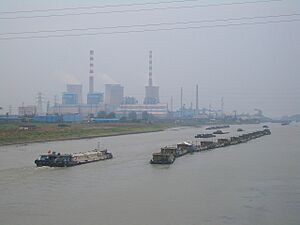
City Transportation
Yangzhou has a large public bus system. You can get around the city easily by bus.
The taxi industry in Yangzhou started in 1982 and has grown quickly. There are over 40 taxi companies with more than 1,500 vehicles. You can find taxis at train stations and hotels. Many companies also offer 24-hour phone service.
In 2014, Yangzhou's government approved plans to build a subway system. It will start with two lines. Line 1 will go east-west, connecting Yangzhou Railway Station to the city center and the new high-speed railway station. Line 2 will run north-south.
Getting Around for Tourists
To help tourists, special sightseeing buses have been started. These buses have tour guides. The route starts from Yangzhou station and stops at famous places like the Slender West Lake, Daming Temple, and Five-Pavilion Bridge. Public buses also have special tourist lines (No. 1, No. 2, and No. 5) that go to popular attractions like the Slender West Lake, Ge Garden, and He Garden. You can also take a boat tour on the Slender West Lake to see many beautiful spots.
Yangzhou's Industries and Shipyards
Yangzhou is home to the Chengxi shipyard. This is a big shipyard that builds large ships, like bulk carriers. It's partly owned by the state-owned CSSC company. Chengxi Yangzhou shipyard builds ships ranging from 25,000 to 170,000 tons.
Yangzhou's Rich Culture
The Yangzhou dialect of Chinese is similar to the official language used in the Ming and Qing courts. It's a bit different from modern Standard Chinese, but people can still mostly understand each other.
During a time when Yangzhou was rich and favored by emperors, storytelling and painting became very popular. A creative painter named Shitao lived in Yangzhou. Later, a group of painters called the Eight Eccentrics of Yangzhou became famous throughout China.
Jiang Zemin, a former leader of China, was born and grew up in Yangzhou. His middle school is still there.
Yangzhou is known for its beautiful carved lacquerware and jade.
The city is also famous for its food, especially Huaiyang cuisine. This style of cooking is one of the most important and skillful in China. Locals are very proud of it.
Yangzhou is also known for its public bath houses, embroidery, and paper-cut arts and crafts. In 2006, the city received the Habitat Scroll of Honor award.
Yangzhou is also very famous for making toys, especially stuffed animals. Many tourists come from nearby cities to buy good-quality, low-priced toys.
Another special part of Yangzhou's culture is an old folk art called Yangzhou storytelling (扬州评话). It's like traditional Chinese comedy. It started in the Ming dynasty. In this performance, an artist tells interesting historical stories in the Yangzhou dialect. These stories are made exciting and funny by the artists. The most famous Yangzhou storyteller was Wang shaotang.
Exploring Yangzhou: Tourist Attractions
Yangzhou has many beautiful places to visit, like the Slender West Lake and old houses in the walled city. It's famous for its well-kept Yangzhou-style gardens. Most of the historic city is in the Guangling District.
Slender West Lake: A Scenic Gem
This long, narrow lake is named after the famous West Lake in Hangzhou. It winds through the western part of Yangzhou and is a well-known beautiful spot. A long bank with weeping willow trees stretches across the lake. In the middle, you'll find the Five-Pavilion Bridge with five covered terraces. Around the lake is a park with several attractions:
- Xu Garden
- The White Dagoba of Lianxing Temple, which looks like a tower in Beijing's Beihai Park.
- Small Gold Mountain (Xiao Jinshan).
- The Fishing Platform (Diaoyutai), a favorite spot of the Qing emperor Qian Long. He loved fishing here so much that he gave extra money to the town. It turns out, local swimmers were secretly attaching fish to his hook!
Daming Temple: A Historic Buddhist Site
Located on Shugang Hill in the city's northwest, Fajing Temple was once known as DaMing Temple. The first temple was built between 420 and 479 AD. A nine-story pagoda, the Qilingta, was added to the temple grounds around 589-618 AD. A newer part of the temple is the Jianzhen Memorial Hall. It was built using old Tang dynasty methods and funded by Buddhist groups in Japan.
When Qing Emperor Qian Long visited Yangzhou in 1765, he didn't like the name DaMing (meaning "Great Ming"). He worried it might remind people of the Ming dynasty, which his family had overthrown. So, he had it renamed Fajing Temple.
The temple was badly damaged during the Taiping Rebellion in the early 1900s. The buildings you see today were rebuilt in the 1930s.
Flat Hills Hall: A Scholar's View
This hall was built by the Song dynasty writer Ouyang Xiu. He was a city official at the time. From this hall, the mountains south of the Yangtze River look like a flat line at eye level. That's why it's called Flat Hills Hall. When Ouyang Xiu's student Su Dongpo became an official in Yangzhou, he built another hall right behind his teacher's. He called it Guling Hall.
Pavilion of Flourishing Culture: City's Heart
The Pavilion of Flourishing Culture (Wénchāng Gé) is a round, three-story building in eastern Yangzhou. It was built in 1585 to celebrate the city's rich culture. It's also considered the center of the city.
Built during the Ming dynasty, it's located at the crossing of Wenchang Road and Wenhe Road. The building is about 79 feet tall and looks a bit like the Temple of Heaven in Beijing. Today, with many shops around it, the Wenchange has become a symbol of the city's commercial area.
Stone Pagoda: Yangzhou's Oldest Pagoda
The Stone Pagoda (Shítǎ) is a five-story pagoda from the Tang dynasty. It's west of the Pavilion of Flourishing Culture. First built in 837, it's the oldest pagoda still standing in Yangzhou.
Tomb of Puhaddin: A Historic Muslim Site
This is a graveyard from the Ming dynasty that includes the tomb of Puhaddin. According to information at the tomb, he was a 16th-generation descendant of the prophet Muhammad. The tomb is on the east bank of the Old Grand Canal and next to a mosque. The mosque has many important items about China's connections with Muslim countries.
Ge Garden: A Beautiful Chinese Garden
Ge Garden (Geyuan) is a beautiful Chinese garden. It's considered one of the most refined in China. It was built by a rich salt merchant named Huang Zhiyun. He named it to honor the bamboo that appears in his name and throughout the garden. The garden is especially famous for its four rockeries, which are designed to represent the different seasons.
He Garden: A Garden with a Long Corridor
He Garden (Heyuan), also known as the Jixiao Shanzhuang, was built by a government official named He Zhidao in the 1800s. The garden is famous for its winding, 430-meter-long, two-story corridor. The walls of this corridor are covered with stone tablets carved with classical poems. The garden also has an outdoor theater on an island in the middle of a fish pond.
Yechun Garden: A Rustic Retreat
Yechun Garden (Yechunyuan) is located on the banks of the Xiading River in the northern part of the city. In the Qing dynasty, the poet Wang Yuyang and his friends used to meet in this garden to read their poems. The thatched roofs of the buildings in this garden give it a charming, rustic feel.
Yangzhou Museum: History and Printing
The Yangzhou Museum is on the west shore of Bright Moon Lake. Its design is meant to show harmony between people and nature. The museum itself, which covers the history of Yangzhou and nearby areas, is on the third floor. Other floors are separate museums, including the Chinese Block Printing Museum. This museum was created in 2003 to hold 300,000 printing blocks. Together, these museums cover a large area of 50,000 square meters.
Jiangdu Hydro Project: Moving Water North
The Jiangdu Hydro Project is the starting point of the eastern route of the South–North Water Transfer Project. This huge project aims to move large amounts of fresh water from the Yangtze River to drier northern parts of China, following the route of the Grand Canal. Construction of the pumping stations began in 1961 and was finished in 1975. The project helps with irrigation, drainage, boat travel, and making electricity. It includes four large electric pumping stations and other important structures.
Learning in Yangzhou: Education
Universities and Colleges in Yangzhou
- Yangzhou University
- Yangzhou Polytechnic College
- Yangzhou Polytechnic Institute
- Yangzhou Medical University
Schools for Younger Students
- Yangzhou High School of Jiangsu Province
- HanJiang High School Of Jiangsu Province
- Yangzhou Xinhua High School
- Shuren School of Yangzhou Middle School Education Group
- High School Affiliated to Yangzhou University
- Yangzhou NO.1 Middle School
- Guazhou High School
- Jiangdu High School of Jiangsu Province
- Baoying High School of Jiangsu Province
- Gaoyou High School of Jiangsu Province
- Yizheng High School of Jiangsu Province
Yangzhou's Sister Cities
 Balashikha, Moscow Oblast, Russia
Balashikha, Moscow Oblast, Russia Kent, Washington, US
Kent, Washington, US Malacca City, Malaysia
Malacca City, Malaysia Neubrandenburg, Germany
Neubrandenburg, Germany Offenbach am Main, Germany (since 1997)
Offenbach am Main, Germany (since 1997) Orléans, France
Orléans, France Nara, Japan
Nara, Japan Porirua, New Zealand
Porirua, New Zealand Vaughan, Ontario, Canada
Vaughan, Ontario, Canada Westport, Connecticut, US
Westport, Connecticut, US Colchester, UK
Colchester, UK
See also
 In Spanish: Yangzhou para niños
In Spanish: Yangzhou para niños



